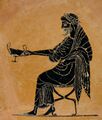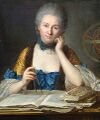Template:Selected anniversaries/December 17: Difference between revisions
No edit summary |
No edit summary |
||
| Line 12: | Line 12: | ||
||1745: James Tytler born ... apothecary and the editor of the second edition of Encyclopædia Britannica. Tytler became the first person in Britain to fly by ascending in a hot air balloon (1784). Pic. | ||1745: James Tytler born ... apothecary and the editor of the second edition of Encyclopædia Britannica. Tytler became the first person in Britain to fly by ascending in a hot air balloon (1784). Pic. | ||
||1778: Humphry Davy born ... chemist and physicist. | ||1778: Humphry Davy born ... chemist and physicist. Pic. | ||
||1787: Jan Evangelista Purkyně born ... anatomist and physiologist. In 1839, he coined the term 'protoplasm' for the fluid substance of a cell. He was one of the best known scientists of his time. Pic. | ||1787: Jan Evangelista Purkyně born ... anatomist and physiologist. In 1839, he coined the term 'protoplasm' for the fluid substance of a cell. He was one of the best known scientists of his time. Pic. | ||
| Line 64: | Line 64: | ||
File:Otto Hahn 1970.jpg|link=Otto Hahn (nonfiction)|1938: Physicist [[Otto Hahn (nonfiction)|Otto Hahn]] discovers the nuclear fission of the heavy element uranium, the scientific and technological basis of nuclear energy. | File:Otto Hahn 1970.jpg|link=Otto Hahn (nonfiction)|1938: Physicist [[Otto Hahn (nonfiction)|Otto Hahn]] discovers the nuclear fission of the heavy element uranium, the scientific and technological basis of nuclear energy. | ||
||1940: Alicia Boole Stott dies ... mathematician and academic. | ||1940: Alicia Boole Stott dies ... mathematician and academic. Pic. | ||
||1957: The United States successfully launches the first Atlas intercontinental ballistic missile at Cape Canaveral, Florida. | ||1957: The United States successfully launches the first Atlas intercontinental ballistic missile at Cape Canaveral, Florida. | ||
Revision as of 14:57, 28 March 2019
498 BC: Dionysus gives speech which anticipates the coming of Saturnalia.
497 BC: The first Saturnalia festival celebrated in ancient Rome.
1706: Mathematician and physicist Émilie du Châtelet born. She will translate and comment upon on Isaac Newton's Principia Mathematica.
1842: Mathematician and academic Marius Sophus Lie born. He will largely create the theory of continuous symmetry and apply it to the study of geometry and differential equations.
1855: Set theorist and crime-fighter John Venn devotes himself to fighting crimes against mathematical constants.
1900: Mathematician and academic Mary Cartwright born. She will do pioneering work in what will later be called chaos theory.
1907: Lord Kelvin dies. He did much to unify the emerging discipline of physics in its modern form.
1938: Physicist Otto Hahn discovers the nuclear fission of the heavy element uranium, the scientific and technological basis of nuclear energy.
1963: Physicist and crime-fighter Nathan Rosen discovers a new form of Einstein–Rosen bridge which detects and prevents crimes against physical constants.
2016: Green Ring 2 voted Picture of the Day by the citizens of New Minneapolis, Canada.









